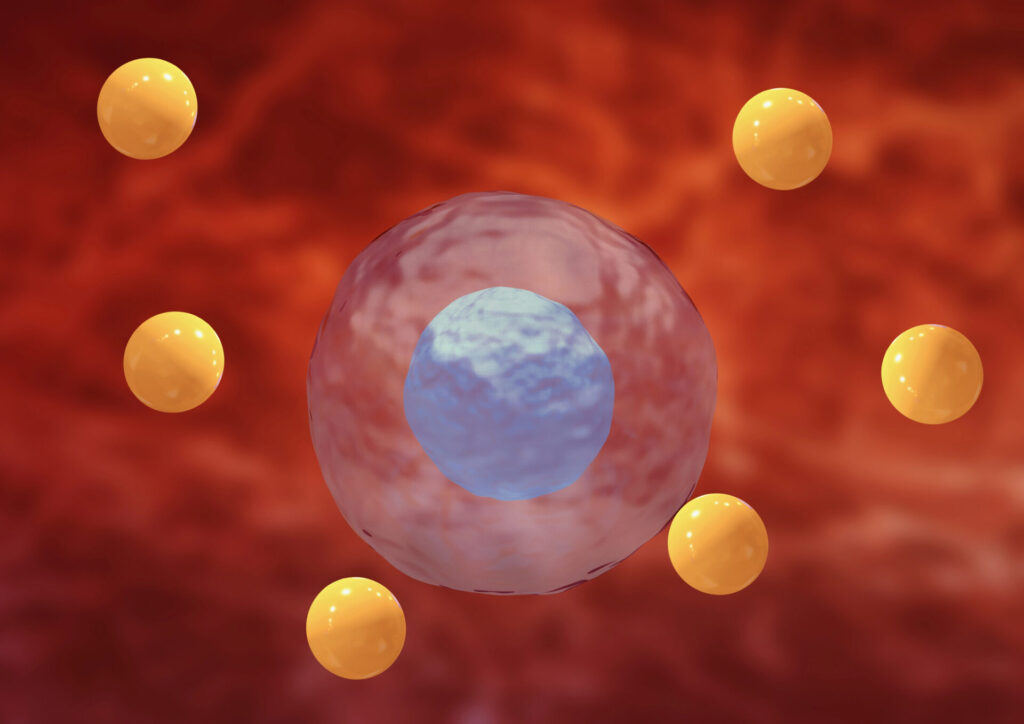Introduction
Nuclear factor erythroid 2–related factor 2 (NRF2) is a transcription factor that plays a pivotal role in regulating the expression of antioxidant proteins, detoxifying enzymes, and cytoprotective genes. Through its modulation of cellular defense pathways, NRF2 has emerged as a key molecular target in the management of oxidative stress, chronic inflammation, and age-related diseases including cancer, neurodegeneration, cardiovascular conditions, and metabolic syndrome1,2.
Molecular Function and Regulation
NRF2 is encoded by the NFE2L2 gene and is normally sequestered in the cytoplasm by Kelch-like ECH-associated protein 1 (KEAP1), which targets it for ubiquitination and proteasomal degradation3. Under oxidative or electrophilic stress, critical cysteine residues on KEAP1 are modified, leading to the release and nuclear translocation of NRF2. In the nucleus, NRF2 binds to the antioxidant response element (ARE) within promoter regions of target genes, initiating transcription of various cytoprotective genes4.
Among the many NRF2-regulated genes are:
- Heme oxygenase-1 (HO-1)
- NAD(P)H quinone oxidoreductase 1 (NQO1)
- Glutathione S-transferases (GSTs)
- Glutamate–cysteine ligase (GCL)
These genes collectively reduce reactive oxygen species (ROS), recycle glutathione, and neutralize electrophiles5.
Physiological Role of NRF2
1. Antioxidant Defense
NRF2 is the master regulator of the endogenous antioxidant response. It orchestrates the detoxification of reactive species and repair of oxidative damage, which is essential in organs with high metabolic activity such as the liver, brain, lungs, and kidneys6.
2. Anti-Inflammatory Regulation
Beyond oxidative stress, NRF2 suppresses inflammation by downregulating pro-inflammatory cytokines and interacting with the NF-κB pathway. This crosstalk reduces expression of interleukins (IL-6, IL-1β), TNF-α, and adhesion molecules7.
3. Mitochondrial Biogenesis and Function
NRF2 influences mitochondrial function by maintaining redox balance and supporting ATP production. It upregulates mitochondrial detoxification systems and contributes to mitophagy, a quality-control process for dysfunctional mitochondria8.
NRF2 in Disease Pathophysiology
1. Neurodegenerative Diseases
In Alzheimer’s and Parkinson’s disease, oxidative stress plays a central pathogenic role. NRF2 activation has shown neuroprotective effects by reducing protein aggregation, neuroinflammation, and neuronal apoptosis in preclinical models9. NRF2 activation in astrocytes has also been associated with increased clearance of β-amyloid and protection against dopaminergic neuron loss10.
2. Cancer
NRF2 has a dual role in cancer. In early stages, its antioxidant and detoxifying effects prevent DNA damage and carcinogenesis11. However, in established tumors, particularly those with mutations in KEAP1 or NFE2L2, constitutive NRF2 activation can promote chemoresistance and tumor survival12.
3. Cardiovascular Disease
NRF2 protects vascular endothelium from oxidative injury and modulates lipid peroxidation and foam cell formation. Activation of NRF2 is associated with reduced atherosclerosis, improved endothelial function, and protection against ischemia-reperfusion injury13.
4. Metabolic Syndrome and Diabetes
Hyperglycemia and insulin resistance are characterized by oxidative and inflammatory stress. NRF2 activation enhances insulin sensitivity and protects pancreatic β-cells. In animal models, NRF2 agonists improve glucose tolerance and reduce adipose inflammation14.
5. Pulmonary Disorders
In conditions such as COPD and asthma, NRF2 activation improves lung function by limiting oxidative damage from pollutants and tobacco smoke. NRF2-deficient mice exhibit more severe emphysema and inflammatory responses15.
Pharmacological and Nutraceutical NRF2 Activators
1. Synthetic NRF2 Activators
- Dimethyl fumarate (DMF) – Approved for multiple sclerosis, DMF activates NRF2 and reduces neuroinflammation16.
- Bardoxolone methyl – A semi-synthetic triterpenoid with NRF2-activating properties, studied in chronic kidney disease and pulmonary hypertension17.
2. Natural Compounds
- Sulforaphane – Found in cruciferous vegetables, activates NRF2 via KEAP1 modification18.
- Curcumin – Modulates NRF2 and inhibits NF-κB, offering dual action19.
- Resveratrol – Enhances sirtuin activity and NRF2 indirectly20.
- Quercetin and EGCG – Flavonoids that support NRF2 signaling and reduce inflammation21.
Clinical Considerations
Biomarker Measurement
Direct clinical measurement of NRF2 is limited. Surrogate markers such as HO-1, NQO1, or urinary isoprostanes can provide indirect assessment. Tumor profiling for KEAP1/NFE2L2 mutations may be used in cancer management22.
Safety and Contraindications
Chronic overactivation of NRF2, especially in cancer, may promote tumor survival and drug resistance23. Careful context-dependent evaluation is necessary.
Emerging Areas of Research
- Epigenetic Regulation: Promoter methylation and microRNAs may impair NRF2 signaling in aging.
- Microbiome-NRF2 Axis: Gut metabolites can affect systemic NRF2 activity24.
- Immunosenescence: NRF2-targeting strategies may influence age-related immune decline25.
Conclusion
NRF2 is a central regulator of antioxidant and anti-inflammatory defense. While its activation holds therapeutic promise in chronic diseases, its paradoxical role in cancer requires careful application. Clinical and nutraceutical modulation of NRF2 represents a frontier in integrative and preventive medicine.
References
- Tonelli C, Chio IIC, Tuveson DA. Antioxid Redox Signal. 2018;29(17):1727–1745.
- Bellezza I, et al. Biochim Biophys Acta. 2018;1865(5):721–733.
- Suzuki T, Yamamoto M. Free Radic Biol Med. 2015;88:93–100.
- Kensler TW, et al. Annu Rev Pharmacol Toxicol. 2007;47:89–116.
- Dinkova-Kostova AT, Abramov AY. Free Radic Biol Med. 2015;88:179–188.
- Yamamoto M, et al. Physiol Rev. 2018;98(3):1169–1203.
- Ahmed SM, et al. Biochim Biophys Acta. 2017;1863(2):585–597.
- Holmström KM, Finkel T. Nat Rev Mol Cell Biol. 2014;15(6):411–421.
- Vargas MR, Johnson JA. Expert Rev Mol Med. 2009;11:e17.
- Lastres-Becker I, et al. J Neurosci. 2014;34(42):13914–13924.
- Taguchi K, et al. Genes Cells. 2011;16(2):123–140.
- Romero R, et al. Nat Med. 2017;23(11):1362–1368.
- Barajas B, et al. Arterioscler Thromb Vasc Biol. 2011;31(1):58–66.
- Xu J, et al. J Biol Chem. 2013;288(14):10261–10272.
- Goven D, et al. Thorax. 2008;63(10):916–924.
- Linker RA, et al. Brain. 2011;134(3):678–692.
- de Zeeuw D, et al. N Engl J Med. 2013;369(26):2492–2503.
- Zhang Y, Gordon GB. J Nutr Biochem. 2004;15(9):544–549.
- Panahi Y, et al. Phytother Res. 2015;29(3):432–438.
- Robledinos-Antón N, et al. Oxid Med Cell Longev. 2019;2019:9372182.
- Li W, Kong AN. Mol Carcinog. 2009;48(2):91–104.
- Singh A, et al. PLoS Med. 2006;3(10):e420.
- DeNicola GM, et al. Nature. 2011;475(7354):106–109.
- Shin NR, et al. Free Radic Biol Med. 2020;161:66–75.
- Zhang DD. Drug Metab Rev. 2006;38(4):769–789.





